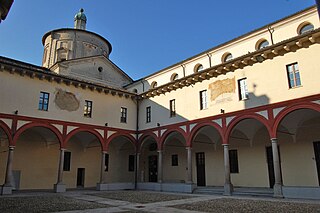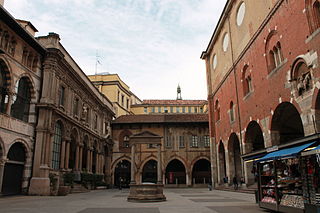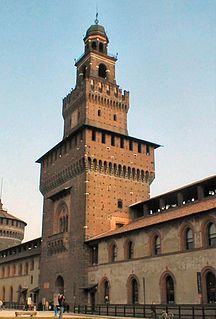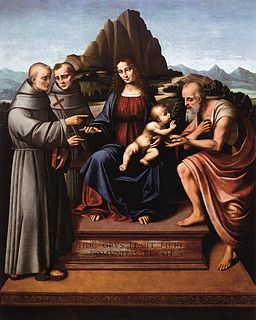
The province of Lodi is a province in the Lombardy region of Italy. Its provincial capital is the city of Lodi. As of 2017, it has a population of 229,541 inhabitants over an area of c. 783 square kilometres (300 sq mi), giving the province a population density of 293.2 inhabitants per square kilometre. The provincial president is Francesco Passerini.

The Province of Milan was a province in the Lombardy region, Italy. Its capital was the city of Milan. The provincial territory was highly urbanized, resulting in the third highest population density among the Italian provinces with more than 2,000 inhabitants/km2, just behind the provinces of Naples and the bordering Monza e Brianza, created in 2004 splitting the north-eastern part from the province of Milan itself. On January 1, 2015 it was replaced by the Metropolitan City of Milan.

The Province of Monza and Brianza,, is an administrative province of Lombardy region, Italy.

Piazza del Duomo is the main piazza of Milan, Italy. It is named after, and dominated by, the Milan Cathedral. The piazza marks the center of the city, both in a geographic sense and because of its importance from an artistic, cultural, and social point of view. Rectangular in shape, with an overall area of 17,000 m2, the piazza includes some of the most important buildings of Milan, as well some of the most prestigious commercial activities, and it is by far the foremost tourist attraction of the city.

FAEMA primarily engaged in the production of espresso machines, was founded in 1945 by Carlo Ernesto Valente, in Milan, Italy. Faema was to become synonymous with the post-war production boom in Italy, by actively pursuing technological innovation as the company's driving force.

The Portinari Chapel is a Renaissance chapel at the Basilica of Sant'Eustorgio, Milan, northern Italy. Commenced in 1460 and completed in 1468, it was commissioned by Pigello Portinari as a private sepulchre and to house a silver shrine given by Archbishop Giovanni Visconti in 1340 containing the relic head of St. Peter of Verona, to whom the chapel is consecrated. The architect is unknown, the traditional attribution to Michelozzo having been succeeded with equal uncertainty by attributions to either Filarete or Guiniforte Solari, architect of the apses of the Certosa di Pavia and the church of San Pietro in Gessate in Milan.

Piazza Cordusio is a square in central Milan, Italy. The piazza takes its name from the Cors Ducis which was found in the square during Longobard times. It is well known for its several turn-of-the-19th-century Neoclassical, eclectic and Art Nouveau buildings, banks and post offices. Even though many of these have now relocated elsewhere, it is still an important commercial square in the city and hosts the Palazzo delle Assicurazioni Generali, the Palazzo del Credito Italiano and the Palazzo delle Poste, former Borsa di Milano. Piazzale Cordusio hosts the Cordusio metro station and is the starting point of the elegant pedestrian Via Dante which leads to the imposing medieval Castello Sforzesco, or Milan Castle. Opposite to Via Dante, Cordusio borders onto Piazza Mercanti, former city centre in the Middle Ages, which leads directly to Piazza del Duomo, today's city centre.
Porta Monforte is a district ("quartiere") of Milan, Italy, located within the Zone 3 administrative division. It is named after the eponymous city gate, which was added in the 1890s to the existing Spanish walls of the city. The gate was meant to serve as a customs office; the tax booths were designed by Luigi Tormenti and completed in 1889. While the addition of the Monforte city gate was intended to absorb part of the traffic going through Porta Venezia and Porta Vittoria, Porta Monforte remained a minor gate. The gate itself has since been demolished; it was located in what is now Piazza del Tricolore.

Porta Vittoria was a city gate in the Spanish walls of Milan, Italy. While the walls and the gate have been demolished, the name "Porta Vittoria" has remained to refer to the district ("quartiere") where the gate used to be. This district is part of the Zone 4 administrative division of Milan.

The Alfa Romeo Portello Plant in Portello Milan, Italy was the first Alfa Romeo factory, and the main factory between 1908 and the 1960s. The factory was closed in 1986, but all major production had already been transferred 20 years earlier to the Alfa Romeo Arese Plant. The history of the factory is primarily involved in automobile manufacture, but over the years other products were manufactured as well.

Piazza Mercanti is a central city square of Milan, Italy. It is located between Piazza del Duomo, which marks the centre of the modern city of Milan, and Piazza Cordusio, and it used to be the heart of the city in the Middle Ages. At the time, the square was larger than it is now and known as "Piazza del Broletto", after the "Broletto Nuovo", the palace that occupied the centre of the square. In the 13th century, there were six entry points to the square, each associated to a specific trade, from sword blacksmiths to hat makers.

Piazza della Scala is a pedestrian central square of Milan, Italy, connected to the main square of Milan, Piazza del Duomo, by the Galleria Vittorio Emanuele II passage. It is named after the renowned Teatro alla Scala opera house, which occupies the north-western side of the square; the building actually includes both the opera house and the Museo Teatrale alla Scala, dedicated to the history of La Scala and opera in general. On the opposite side to "La Scala", to the south-east, is the facade of Palazzo Marino, Milan's city hall. Another relevant building on the square, on the north-eastern side, is the Palazzo della Banca Commerciale Italiana. The south-western side of the square has the entry to the Galleria Vittorio Emanuele as well as Palazzo Beltrami. Most of the architecture of the square is due to architect Luca Beltrami, who designed the eponymous palace, the facade of Palazzo Marino, and the Banca Commerciale Italiana building. The centre of the square is marked by the monument of Leonardo da Vinci by sculptor Pietro Magni (1872).

The Museo Egizio is a museum sited in the Sforza Castle of Milan, Italy. The Castle is one of the most famous monuments in Milan and is home to several museums including the Egyptian Section of the Milan Archaeological Museum, the Museum of Ancient Art, the Pinacoteca and the Museum of Musical Instruments.

The Museo d'Arte Antica is an art museum in the Castello Sforzesco of Milan, in Lombardy in northern Italy. It has a large collection of sculpture from the late antiquity, Mediaeval and Renaissance periods. The various frescoed rooms of the museum house an armoury, a tapestry room, some funerary monuments, the Rondanini Pietà and two mediaeval portals.

The Palazzo Brentani is a historic mansion located in the centre of Milan, Italy, at Via Manzoni number 6. Both this palace and the adjacent Palazzo Anguissola sport Neoclassical facades, designed by Luigi Canonica in 1829.

The Diocesan Museum of Milan is an art museum in Milan housing a permanent collection of sacred artworks, especially from Milan and Lombardy. Originally conceived by Ildefonso Schuster in 1931 as a vehicle to protect and promote the art collection of the Archdiocese of Milan, the museum was eventually established in the former headquarters of the Dominican Order in the back of the Basilica of Sant'Eustorgio with the support of Pope Paul VI. In 2001 Carlo Maria Martini inaugurated the current venue located in Porta Ticinese.

Porta Nuova is one of the two medieval gates of Milan that still exist in the modern city. It is sited along the ancient "Navigli Ring" on the perimeter of the medieval walls of the city.

Casa Manzoni is a historical palace sited in via Morone 1 near the quadrilateral of fashion in the center of Milan, Italy. Owned by the Manzoni family, the house was the birthplace of the famous Italian writer Alessandro Manzoni in 1785.

Piazza San Fedele is sited in Milan near Palazzo Marino, the Vittorio Emanuele II Gallery and Piazza della Scala in a pedestrian area in the centre of the city. The square is sited in front of at the homonymous San Fedele Church built based on an old project by Pellegrino Tibaldi in the 16th century and finally consecrated in the 18th century.
The Allianz Cloud previously known as Palazzetto Lido Sport, commonly known as PalaLido, is a multi-purpose indoor arena that is located in Milan, Lombardy, Italy. The arena's primary use is to host basketball and volleyball games, but it can also be used to host handball, tennis, gymnastics, and wrestling. The arena currently has a seating capacity of 5,420 for sports events. It will host ice sledge hockey in the 2026 Winter Paralympics.

















